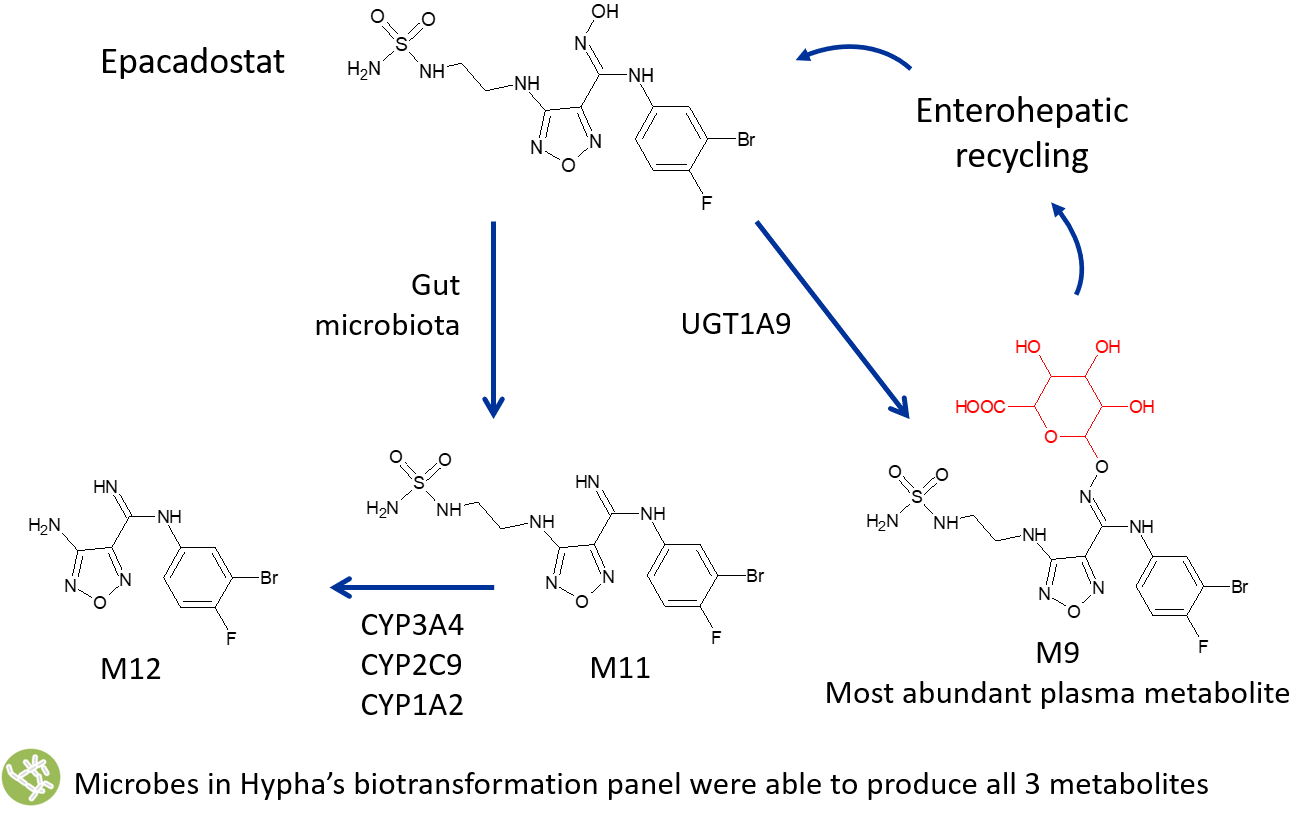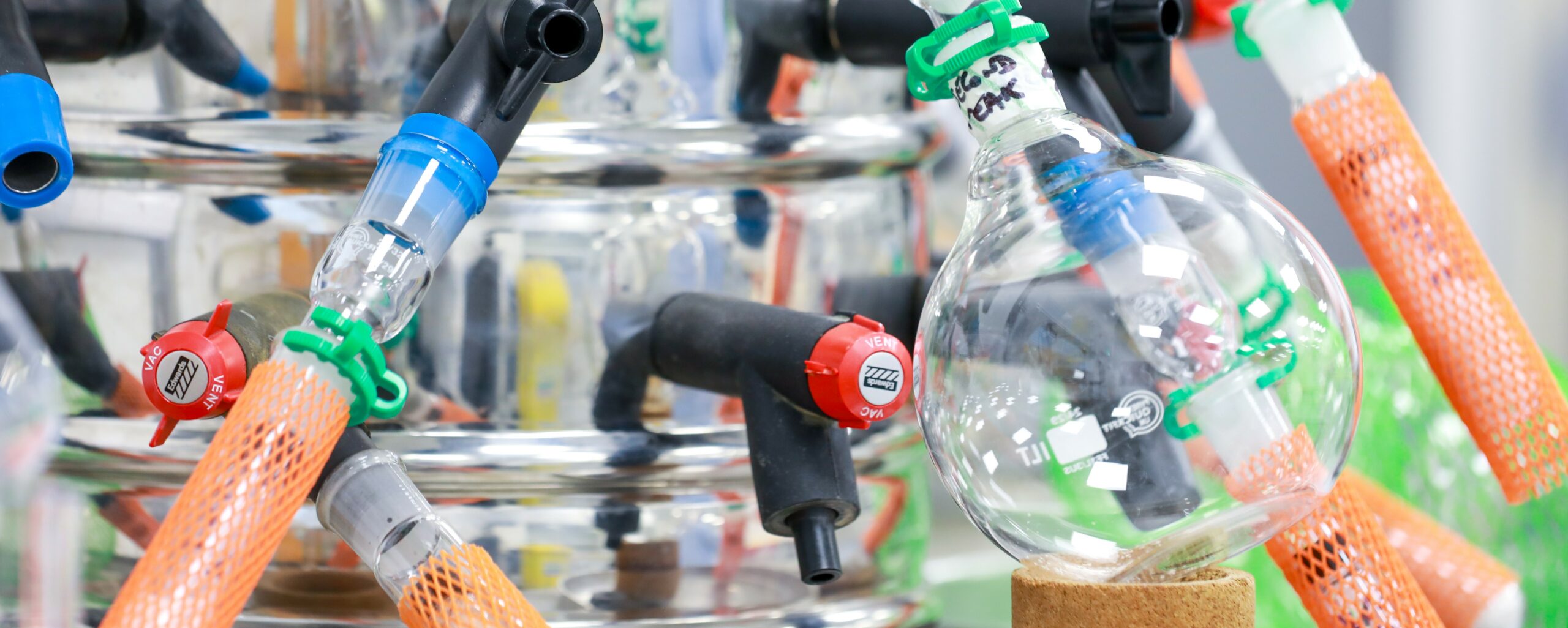Accessing Major Human Drug Metabolites From Mixed Conjugative Pathways
Major circulatory and excretory metabolites of lorcaserin
Lorcaserin is a selective 5-HT2C receptor agonist acting on the hypothalamus to reduce appetite and treat obesity, but which has now been withdrawn from the market. Lorcaserin N-sulfamate (M1) is the major circulating metabolite in plasma with lorcaserin N-carbamoyl glucuronide (M5) being the major excretory metabolite in urine. Screening of lorcaserin against Hypha’s panels of microbes and liver S9 preps gave scalable routes to accessing both metabolites.
 N-carbamoyl glucuronidation is not a common disposition mechanism, however it has been observed for drugs containing primary and secondary amino functionalities and is becoming more frequently reported.1 In humans, lorcaserin glucuronidation is predominantly catalyzed by three UDP-glucuronyltransferases (UGT2B7, UGT2B15 and UGT2B17).2 Hypha’s microbes were able to replicate the action of these human UGTs to produce the same metabolite. In total, four microbes in Hypha’s Phase 2 screening panel of 23 strains were able to produce the N-carbamoyl glucuronide. One strain was scaled up to 0.5L to generate 10 mg of purified material from 50 mg of parent compound for structure confirmation by NMR spectroscopy. Various hydroxylated metabolites of lorcaserin were also formed by at least 4 other strains. Hypha’s late-stage chemical synthesis is also an effective route for making N-carbamoyl glucuronides.
N-carbamoyl glucuronidation is not a common disposition mechanism, however it has been observed for drugs containing primary and secondary amino functionalities and is becoming more frequently reported.1 In humans, lorcaserin glucuronidation is predominantly catalyzed by three UDP-glucuronyltransferases (UGT2B7, UGT2B15 and UGT2B17).2 Hypha’s microbes were able to replicate the action of these human UGTs to produce the same metabolite. In total, four microbes in Hypha’s Phase 2 screening panel of 23 strains were able to produce the N-carbamoyl glucuronide. One strain was scaled up to 0.5L to generate 10 mg of purified material from 50 mg of parent compound for structure confirmation by NMR spectroscopy. Various hydroxylated metabolites of lorcaserin were also formed by at least 4 other strains. Hypha’s late-stage chemical synthesis is also an effective route for making N-carbamoyl glucuronides.
In humans, sulfotransferases (SULTS) catalyse formation of the lorcaserin N-sulfamate metabolite (M1) via multiple SULT isoforms with SULT1A1 reported as the most efficient.3 Seven species in Hypha’s mammalian liver S9 panel were able to produce the target metabolite with canine and primate species being the best producers of M1.
Employing multiple screening tools in Hypha’s one-stop metabolite shop to access human drug metabolites, as exemplified here for lorcaserin, offers an excellent scalable route for obtaining key metabolites needed for clinical development programs.
References
1. Gundez et al., 2010. Drug Metab. Dispos. 38 (3), 361-7
2. Sadeque et al., 2012. Drug Metab. Dispos. 40 (4), 772-8
3. Sadeque et al., 2016. Drug Metab. Dispos. 44 (4), 570-5
Related Resources
Formation and scale-up of human metabolites formed through mixed metabolic pathways is possible using Hypha’s microbial biocatalysis system. In vivo human metabolism of Incyte’s IND epacadostat (EPA) forms 3 major circulating metabolites, from both primary and secondary pathways. Glucuronidation of EPA forms M9, the dominant metabolic pathway, in conjunction with formation of an amidine M11 and an N-dealkylated metabolite, M12.
Hypha’s microbial biocatalysis process is effective at generating metabolites at up to gram scale. Through Hypha and Selcia’s partnership, [13C], [14C], [2H], [3H] and [15N]-labelled metabolites can be accessed to support regulatory, development or research projects in the pharma and crop protection industries. Hypha establishes optimized processes using unlabelled or stable labelled parent substrates, which can then be transferred to Selcia’s state-of-the-art radiochemistry labs for the production of radiolabelled metabolites.
Access to multiple metabolites needed to support clinical development is not always straightforward, and can sometimes mean that more than one technique needs to be applied to fulfil requirements. In one such project, a US pharma client required > 200 mg of three metabolites of a drug; an N-glucuronide (M1), an indirect O-glucuronide (M2b) and a hydroxylated metabolite (M8b). As part of this project, multiple components of Hypha’s one-stop metabolite shop were employed, including chemical synthesis, microbial biotransformation as well as purification and structure elucidation by NMR.


